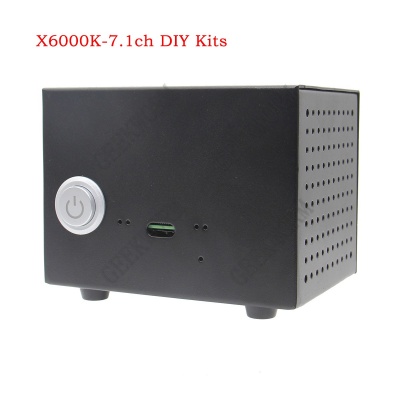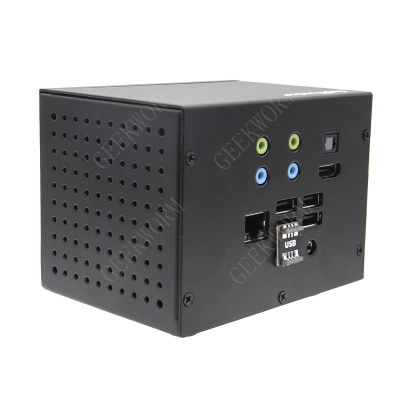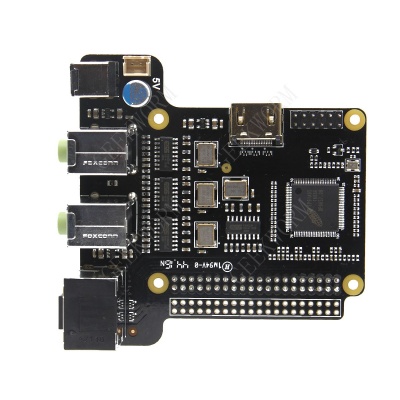X6000K
Features of X6000K 7.1CH
| For Use With | Raspberry Pi 1 Model B+/ 2 Model B / 3 Model B |
| Operating System | - OSMC - 2.0 stereo audio / 5.1 channel surround sound / 7.1 channel surround sound
- Openelec - 2.0 stereo audio / 5.1 channel surround sound / 7.1 channel surround sound - Moode Audio Player - 2.0 stereo audio outputs - Raspbian Jessie - 2.0 stereo audio outputs - Rune audio - 2.0 stereo audio outputs - Pi Core Player - To be tested |
| Key Features | - Ultra-compact chassis
- Ideal for Home Theater Systems - Ideal for 7.1 channel surround audio systems - Used four ESS Tech Sabre premier stereo DACs ES9023 - ES9023 delivers jitter-free studio quality audio with 112dB DNR - Each DAC has independent ultra-low-jitter clock generator - Used the Texas Instruments ultra-low-noise voltage regulator - Supports up to 1TB 2.5-inch SATA hard drives - High quality video performance - Supports SPDIF Optical Digital Audio - Supports HDMI high-bit-rate (HBR) audio - 4 analog stereo 3.5mm jack outputs - Selected high quality components (Solid Capacitors, Murata MLCC etc) - Allows you to split the audio stream from a HDMI signal - No HDMI output connection is required to receive audio at the analog and optical outputs - Connects directly to the Raspberry Pi - no additional cables needed - Powers the Raspberry Pi - no additional power supply - Lighted power switch - Raspberry Pi status LEDs still visible - Access to Raspberry Pi GPIO - Easy to change the Raspberry Pi OS SD card - No need to open the case - Easy DIY with Raspberry Pi |
| Power Supply Unit (Optional Accessories) | - AC 100 - 240V input ~50 / 60Hz, 5Vdc 4A output
- With 2 snap-in plugs for North America (US) and Europe (EU) |
| Specification | - Power supply: +5Vdc +/-5%
- Input Ports: 1 x HDMI - Output Ports: 1 x HDMI, 1 x Optical, 4 x 3.5mm Phone Jack - Analog audio output level: 2V RMS - Optical S/PDIF Audio Sampling Rate: Up to 192 kHz - HDMI Audio Format: LPCM 2/5.1/7.1CH, Dolby Digital 2~5.1CH, DTS 2~5.1CH, Dolby Digital Plus Dolby TrueHD, and DTS-HD Master Audio - Optical Audio Format: LPCM 2CH, Dolby Digital 2~5.1CH, and DTS 2~5.1CH - Size 122mm x 90mm x 90mm |
| Notes | - For use with original power supply unit only
- WARNING: DO NOT APPLY POWER TO YOUR RASPBERRY PI VIA THE PI's MICRO USB SOCKET. - Approx 3 seconds delay to turn on Raspberry Pi after the power button is pressed (The powerful HDMI audio processing chipset needs time to bootup) |
| Packing List | - X6000 Metal Case x 1
- X6000-7.1CH Expansion Board Kit x 1 - X800K HDD Expansion Board Kit x 1 - Accessories kit x 1 - Tool kit x 1 |
Features of X6000K 8.0CH
| For Use With | Raspberry Pi 1 Model B+/ 2 Model B / 3 Model B |
| Operating System | - OSMC - 8-channel L/R audio outputs
- Moode Audio Player - 8-channel L/R audio outputs - Raspbian Jessie - 8-channel L/R audio outputs - Openelec - To be tested - Volumio - To be tested - Rune audio - To be tested - Pi Core Player - To be tested |
| Key Features | - Ultra-compact chassis
- Ideal for car audio entertainment Ideal for stage audio systems - Ideal for multi-channel audio systems - 8-channel stereo audio outputs at the same time even if playing 2-channel audio - Used four ESS Tech Sabre premier stereo DACs ES9023 - ES9023 delivers jitter-free studio quality audio with 112dB DNR - Each DAC has independent ultra-low-jitter clock generator - Used the Texas Instruments ultra-low-noise voltage regulator - Supports up to 1TB 2.5-inch SATA hard drives - High quality video performance - Supports SPDIF Optical Digital Audio - Supports HDMI high-bit-rate (HBR) audio - 4 analog stereo 3.5mm jack outputs - Selected high quality components (Solid Capacitors, Murata MLCC etc) - Allows you to split the audio stream from a HDMI signal - No HDMI output connection is required to receive audio at the analog and optical outputs - Connects directly to the Raspberry Pi - no additional cables needed - Powers the Raspberry Pi - no additional power supply - Lighted power switch - Raspberry Pi status LEDs still visible - Access to Raspberry Pi GPIO - Easy to change the Raspberry Pi OS SD card - No need to open the case - Easy DIY with Raspberry Pi |
| Power Supply Unit (Optional Accessories) | - AC 100 - 240V input ~50 / 60Hz, 5Vdc 4A output
- With 2 snap-in plugs for North America (US) and Europe (EU) |
| Specification | - Power supply: +5Vdc +/-5%
- Input Ports: 1 x HDMI - Output Ports: 1 x HDMI, 1 x Optical, 4 x 3.5mm Phone Jack - Analog audio output level: 2V RMS - Optical S/PDIF Audio Sampling Rate: Up to 192 kHz - HDMI Audio Format: LPCM 8.0CH - Optical Audio Format: LPCM 2CH, Dolby Digital 2~5.1CH, and DTS 2~5.1CH - Size 122mm x 90mm x 90mm |
| Notes | - For use with original power supply unit only
- WARNING: DO NOT APPLY POWER TO YOUR RASPBERRY PI VIA THE PI's MICRO USB SOCKET. - Approx 3 seconds delay to turn on Raspberry Pi after the power button is pressed (The powerful HDMI audio processing chipset needs time to bootup) |
| Packing List | - X6000 Metal Case x 1
- X6000-8.0CH Expansion Board Kit x 1 - X800K HDD Expansion Board Kit x 1 - Accessories kit x 1 - Tool kit x 1 |
Hardware installation
For X6000K-7.1CH DIY Kits, please refer to here: Hardware installation
For X6000K-8.0CH DIY Kits , please refer to here: Hardware Installation
Software Configuration
For X6000K-7.1CH DIY Kits, please refer to here: Software Configuration
For X6000K-8.0CH DIY Kits , please refer to here: Software Configuration
More details please refer to more detail
FAQ
Q1. What do you need to use Raspberry Pi X6000-7.1CH Expansion Board?
(1) A Raspberry Pi board
(2) A DC 5V 4A Power Supply, please refer to 5V 4A Power Supply
(3) A case for X6000(optional)
Q2. Why there is just output 1 on the board have sound?
(1) This board is 7.1 channel surround sound output, so the sound output is depended by your audio file. Because output 1 is for left/right channel (please refer to the below picture). And most music file just have left/right channel. So if your audio file is MP3 file, there just output 1 have sound.
(2) This board is ideal for Home Theater Systems, if you play the video or watch the movies, other channel will work. You could download a mkv file to have a test. Please refer to the Software Configuration to download the test file.
(3) If you still have doubt about this problem, please contact us.



Enable comment auto-refresher
Anonymous user #8
Permalink |
Anonymous user #7
Permalink |
Anonymous user #6
Permalink |
Anonymous user #5
Permalink |
Anonymous user #4
Permalink |
Anonymous user #3
Permalink |
Anonymous user #2
Permalink |
Admin
Anonymous user #1
Permalink |